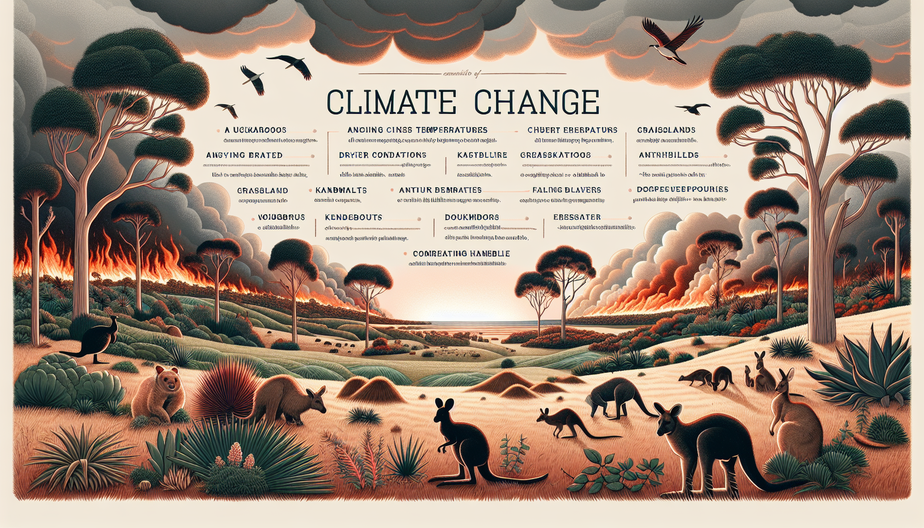When it comes to fire safety, Australia’s jaw-dropping bushfire seasons often feel like nature’s ultimate showdown. From scorching summer heatwaves to roaring fires that leap across forests, these events are a stark reminder of just how fiery Mother Nature can be. But if you think bushfires are just a part of Australia’s natural rhythm, think again. Climate change is cranking up the heat (literally) on our friend Down Under, making these wildfires bigger, badder, and harder to manage.
At Fire Rescue Classifieds, we’re all about fire safety, firefighting resources, and understanding both the risks and solutions of fire-related challenges. So, grab a drink—or maybe some cold water, considering the topic—and let’s dive into how climate change is fanning the flames of Australia’s well-known bushfires.
The Fiery Fuel: How Climate Change Heats Up Bushfire Seasons
Australian bushfires, or “bushies” as locals might call them, thrive on three key ingredients: heat, fuel, and a spark. Climate change doesn’t just sprinkle a bit of salt on this recipe—it dumps in the whole shaker. Here’s how global warming is turning bushfires up to eleven:
Hotter Temperatures and Heatwaves
Record-breaking heat fuels these fires like nothing else. The hotter it gets, the faster vegetation dries out. And just like crispy bacon, dry vegetation is pure flammable delight (well, unless you’re a firefighter). Climate change is making heatwaves more frequent, more intense, and waaaay longer.
Drought? More Like Mega-Droughts
Climate change isn’t content with just bumping up the thermostat. It’s also locking the water taps. Australia has seen long drought periods that sap moisture from the soil, leaving the land practically yelling, “Burn me!”
El Niño and Other Fancy Weather Patterns
El Niño sounds like a cool surfer dude—until you realize he’s a weather phenomenon that fuels drier and hotter conditions. Since climate change disrupts these natural cycles, we’re seeing more frequent “bad hair days” for Australia’s climate, which feed into the bushfire cycle.
Wind That Carries Fire Like a Gossip Whisper
You know how a little spark can start a fire? Well, strong winds driven by changing climate patterns can take that spark and spread it faster than a viral meme. This is a big factor that spreads bushfires over huge areas in record time.
History’s Hot Hits: Australia’s Biggest Bushfire Disasters
We can’t talk bushfires without a trip down memory lane. Let’s revisit some historical fires that made headlines and scorched their way into disaster history. These aren’t just stories—they’re warnings.
Black Saturday (2009)
Black Saturday isn’t just a dramatic name; it’s a grim milestone in Australia’s bushfire history. With 173 lives lost and over 2,000 homes destroyed, this firestorm came during one of the country’s most extreme heatwaves.
Black Summer (2019-2020)
If Australia’s Black Summer had a movie title, it’d probably be “Fire: The Sequel – Bigger, Hotter, Angrier.” Over 18 million hectares burned, nearly 3 billion animals were impacted, and smoke from the fires even reached New Zealand.
Ash Wednesday (1983)
A fire so fierce, its name sounds like the title of a dystopian novel. Ash Wednesday wreaked havoc across Victoria and South Australia, burning through 2,400 homes and taking 75 lives.
The Ripple Effects: What Bushfires Mean for Communities and Wildlife
Bushfires don’t just burn trees—they scorch lives, uproot families, and devastate natural habitats. Let’s break it down:
Environmental Impact
Australia’s already-struggling wildlife isn’t getting a break. Iconic species like koalas, kangaroos, and wallabies are especially at risk. Fun fact—well, not-so-fun fact—koalas aren’t exactly fast when it comes to fleeing fire, making them particularly vulnerable. Beyond that, bushfires pump lots of carbon emissions into the air, which in turn worsens global warming. Talk about a vicious circle!
Human Consequences
Homes, schools, and beloved neighborhoods don’t stand a chance against the strength of major bushfires. Entire communities have been displaced, and rebuilding after such loss is a monumental challenge—emotionally and financially.
Health Issues
The smoke from bushfires doesn’t just smell bad; it’s harmful to breathe in. Long exposure to these plumes can lead to respiratory problems and worsen conditions like asthma. For firefighters, it’s like inhaling danger with every brave step forward. Not to mention, the mental toll of surviving or battling these blazes can be heavy.
Fighting Fire Smarter, Not Harder: Mitigation Strategies
There’s no putting out all bushfires forever—it’s just not realistic. But understanding the roots of this fiery problem means we can take big steps toward reducing the risk. Here’s what’s cooking in the world of bushfire mitigation:
Controlled Burns (A.K.A. Fighting Fire with Fire)
Ironically, one way to prevent out-of-control bushfires is to start intentional, controlled ones. These targeted burns aim to clear out dry vegetation in a safe, managed way. It’s nature’s version of cleaning out the junk drawer.
Early Warning Systems
The early bird doesn’t get burned. Advanced technology like weather radar, satellite imagery, and AI-powered predictive models are helping us detect and prepare for bushfire conditions before disaster strikes.
Stronger Building Codes
Picture this: a house so fire-resistant it practically laughs in the face of an ember storm. Tougher building regulations—like using fireproof materials—are ensuring homes in fire-prone areas stand a better chance of surviving.
Community Education
Knowledge is power, people! Teaching residents how to prepare for fire season—evacuation routes, emergency kits, and safe zones—can save lives when the flames come knocking.
Global Climate Action
Ultimately, reducing emissions and fighting climate change is key to tackling the root causes of worsening bushfires. Supporting renewable energy, cutting down on fossil fuels, and planting more trees are all steps in the right (less flammable) direction.
Beyond Borders: Why Australia’s Fires Are a Global Wake-Up Call
Australia’s bushfires aren’t just an Australian problem. Their impact ripples across the world in more ways than one:
Carbon Emissions on a Global Scale
Massive bushfires release millions of tons of carbon dioxide into the atmosphere, pushing us further off track from climate commitments.
Weather Effects Beyond Australia
Thick plumes of smoke don’t respect borders, often traveling thousands of miles to affect air quality in other regions. During Black Summer, even New Zealand—over a thousand miles away—experienced hazy skies.
A Warning for Other Fire-Prone Regions
The harsh realities of Australia’s bushfires should serve as a learning opportunity for other countries. Whether it’s California, Greece, or Siberia, everyone dealing with fire risk can learn from Australia’s experiences.
Busting Myths About Bushfires and Climate Change
Let’s tackle some myths that refuse to die—like a flame you just can’t extinguish.
Myth 1: Bushfires are natural and have nothing to do with climate change.
Sure, bushfires are a natural part of Australia’s ecosystem, but the intensity and frequency we see today? That’s climate change giving nature a little too much heat.
Myth 2: Australia’s had bushfires forever; it’s nothing new.
True, but just like classic movies getting CGI reboots, bushfires today are exaggerated versions of what they used to be.
Myth 3: Reducing vegetation will solve the problem.
Removing some vegetation through controlled burns helps, but clear-cutting isn’t the answer. Ecosystems need balance, not deforestation.
Wrapping It All Up
Australia’s bushfires are like Mother Nature’s alarm clock, blaring so loud we can’t hit snooze. Climate change isn’t just making these fire seasons worse; it’s reshaping the life and land Down Under in ways we can’t ignore.
The good news? Awareness is spreading faster than wildfire, and solutions are already in the works—from smarter fire management to global climate action. It’s a team effort, and everyone has a role to play.
At Fire Rescue Classifieds, we’re not just here to connect firefighters with the tools and resources they need; we’re here to spark conversations (pun intended) about fire safety and mitigation. So whether you’re a firefighting pro, a curious reader, or someone just looking to stay informed, let’s keep learning, adapting, and acting.
After all, when it comes to fire safety and protecting our world, we’re all in this together. Now, pass the fire extinguisher, will ya?



